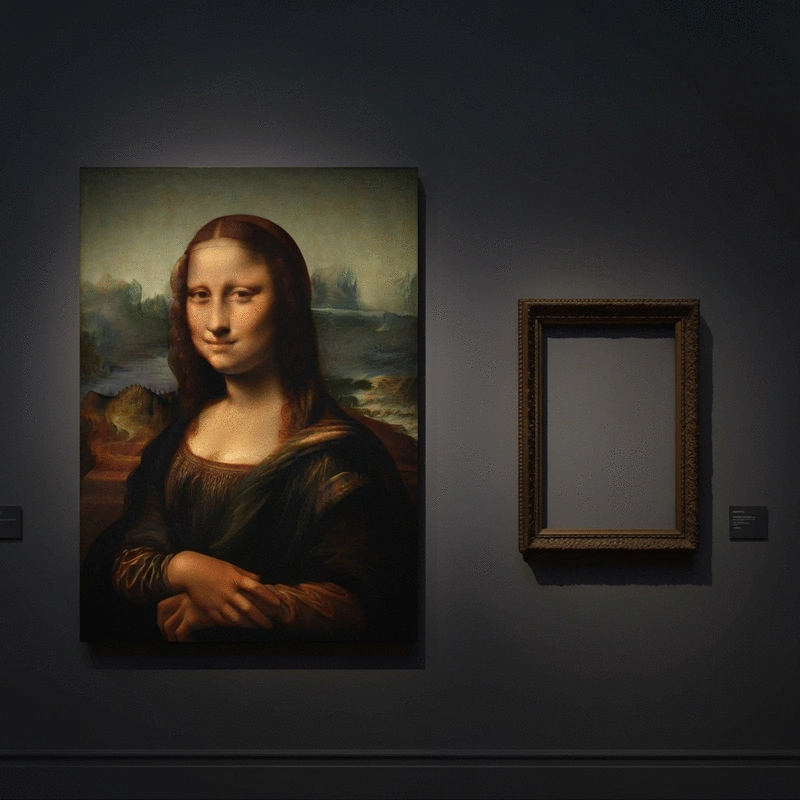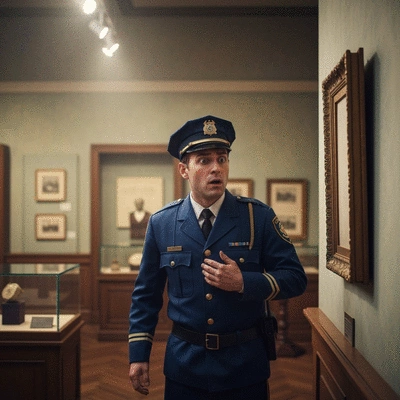Antwerp's Unforgettable Diamond Heist
By Julian Kincaid / Oct 08
When an iconic artwork like the Mona Lisa is stolen, the world watches with bated breath. What drives someone to commit such an audacious act? The tale of its theft in 1911 is not just a story of crime, but a reflection of culture, pride, and the vulnerabilities of the art world.
Below is a visual timeline highlighting the key events from the daring heist of the Mona Lisa to its triumphant recovery, and the lasting impact on art security.
The Mona Lisa vanishes from the Louvre, discovered missing during a routine morning inventory check. This event sparks a global media frenzy.
Police investigation is flawed, leading to false arrests, including poet Guillaume Apollinaire and even Pablo Picasso, adding to the intrigue.
The thief, Vincenzo Peruggia (a former Louvre employee), attempts to sell the painting, claiming a patriotic motive to return it to Italy.
Art dealer Alfredo Geri helps recover the painting in Florence. After a brief exhibition in Italy, the Mona Lisa is returned to the Louvre.
Peruggia receives a light sentence. The theft elevates the Mona Lisa's global status and transforms museum security standards worldwide.
Modern museums employ smart cameras, biometric systems, and AI to protect cultural heritage, a direct result of lessons learned from the 1911 heist.
Welcome to one of the most thrilling tales in the world of true crime! The Mona Lisa, a masterpiece that has captured hearts for centuries, was once at the center of a daring heist that captivated the world. In 1911, this iconic painting was stolen from the Louvre Museum, leading to a series of events that would forever change the art world. Join me as we dive into this incredible story, exploring the motives, methods, and fallout of this infamous theft.
What makes this heist so fascinating? It’s not just about the theft itself; it’s about the people involved and the cultural implications that followed. By uncovering the layers of this historical event, we can better understand the impact it had on art security and public perception of theft.
On a seemingly ordinary day, August 21, 1911, the Mona Lisa vanished without a trace. It was a day that began like any other at the Louvre, with visitors flocking to admire the painting. However, as the sun rose higher, a shocking discovery awaited the museum staff: the beloved painting was gone! How could this happen?
The chaotic atmosphere at the Louvre that day highlighted the vulnerability of even the most protected artworks. As media outlets scrambled to report on the theft, the Mona Lisa became more than just a painting; it transformed into a symbol of art's allure and fragility.
The Louvre, home to thousands of artworks, had always been a fortress of culture and history. Yet, the theft of the Mona Lisa forced the world to reconsider its security measures. Why was this painting so special to begin with? Let's explore its unique attributes:
Understanding the emotional and cultural significance of the Mona Lisa sets the stage for the heist that would make headlines around the world. It wasn’t just a theft; it was a challenge to the very essence of art appreciation.
As we dig deeper into this story, we encounter the man behind the theft: Vincenzo Peruggia. His motivations were complex, intertwining personal beliefs with national pride. What drove a man to steal one of the world's most famous paintings?
Peruggia believed he was acting out of patriotism, convinced that the Mona Lisa belonged in Italy, where it was originally created. His rationale was that the painting should be returned to its homeland, a sentiment that many could find intriguing. But was his act truly noble? Let's break down his perspective:
His motivations challenge us to reflect on the fine line between right and wrong in matters of art and ownership. Is it ever justifiable to take something that doesn't belong to you, no matter how noble the intent?
So, how did Peruggia pull off this audacious theft? His meticulous planning and execution reveal a deep understanding of both the museum's layout and security. Here’s how he managed to slip away with the Mona Lisa:
Peruggia's cleverness and determination remind us that the world of heists often involves a remarkable blend of cunning and strategy. His story highlights not just the act of theft, but the intricate planning that can lie beneath the surface.
Peruggia’s actions were not just a personal vendetta; they were influenced by the broader currents of Italian nationalism that swept through Europe at the time. This cultural context adds depth to his motivations. Consider these points:
By examining the nationalistic fervor underpinning Peruggia's actions, we gain a clearer understanding of how societal influences can shape individual choices. This context enriqueces our exploration of the Mona Lisa theft and its implications for art history.
Following the theft, the investigation that ensued was riddled with errors and miscalculations, leading to a confusing series of events. How did such a high-stakes investigation go awry?
The authorities faced numerous challenges while trying to solve the case, revealing critical flaws in their approach. Some key errors included:
This chaotic approach serves as a reminder of the importance of methodical investigation and clear communication in law enforcement. Each misstep offered valuable lessons for future cases involving art theft.
Among the many wild theories surrounding the theft, names like Pablo Picasso were tossed around as potential suspects. Why was Picasso implicated? Let's explore:
The inclusion of such notable figures in the investigation illustrates how intertwined art, crime, and celebrity can be. It adds a fascinating layer to the tale of the Mona Lisa theft, showcasing how public intrigue can overshadow reality.
Guillaume Apollinaire, a famous poet and friend of Picasso, became an unlikely figure in the investigation. His involvement raises questions about the connections between art and crime:
Apollinaire’s role in the case serves as a reminder of the complexities surrounding art theft. It emphasizes how cultural figures can become entangled in the narratives of crime, complicating our understanding of both the art world and law enforcement efforts.
The Mona Lisa's eventual recovery was nothing short of dramatic, and the story of how it returned to the Louvre is equally riveting!
Enter Alfredo Geri, an art dealer who played a pivotal role in the Mona Lisa's recovery. His actions were driven by both curiosity and a sense of duty. Here’s how Geri made his mark:
This remarkable twist in the tale emphasizes the crucial role of art dealers in protecting cultural heritage. It also illustrates the importance of vigilance and integrity in the art world.
Once Peruggia was apprehended, a trial followed that captured the public's attention. What transpired during the courtroom drama? Let’s break it down:
The trial serves as an interesting case study in public perception and legal outcomes concerning art theft. It reveals how societal values and sentiments can influence judicial proceedings.
The return of the Mona Lisa to France was celebrated, symbolizing not just the recovery of a masterpiece but a restoration of national pride. The public reaction was overwhelming:
This moment was pivotal in shaping how society views both art and the stories behind it. The theft didn’t just highlight vulnerabilities; it also reinforced the significance of cultural identity and pride.
As we reflect on the Mona Lisa theft, we must consider its lasting effects on art and culture. What legacy did this incident leave behind?
The theft of the Mona Lisa didn't diminish its value; instead, it propelled the painting to iconic status. Here are a few ways it changed perceptions:
This elevation of status highlights how the narratives surrounding art can transform its significance, turning even a theft into a powerful story.
Over time, the perception of art theft has evolved significantly. The Mona Lisa heist played a crucial role in shaping this narrative, contributing to broader legal quests for repatriation of cultural objects. Consider these shifts:
These changes in perception remind us that art theft is not just a crime; it’s a complex issue that involves cultural, economic, and ethical considerations.
The Mona Lisa theft is only one of many art crimes that have intrigued the public. Such events contribute to a broader conversation about art's role in society:
As we explore these themes, we uncover a rich tapestry of stories that link crime, culture, and art, inviting us to engage with these narratives on a deeper level.
Finally, let’s turn our attention to the lessons learned from the Mona Lisa heist. How have security measures evolved since 1911?
The security of art has come a long way since the early 20th century. Here’s a comparison of then and now:
This evolution showcases how museums have recognized the importance of protecting their collections, leading to enhanced security measures that help prevent theft.
As we consider modern art theft prevention, insights from industry experts provide valuable context. Here’s what some professionals have to say:
These insights remind us that securing art requires a multifaceted approach, combining technology, training, and community engagement.
The technological advancements in art theft prevention are remarkable. Let’s explore some key innovations:
The evolution of security technologies demonstrates that protecting cultural heritage is a dynamic and ongoing process. As we move forward, it’s essential that we continue to adapt and innovate in response to new challenges.
As we conclude this journey through the Mona Lisa heist, it’s important to reflect on what motivates individuals to commit such audacious crimes. What drives a thief to steal art?
Vincenzo Peruggia's motivations are complex and layered. Here are some key psychological factors to consider:
Understanding the mindset of thieves like Peruggia allows us to explore the deeper motivations that drive such actions, offering insights into human behavior.
While Peruggia’s story is compelling, it’s important to recognize the broader motivations behind art theft. Here’s a look at some common drivers:
By examining these motivations, we can gain a deeper understanding of the complex world of art theft, shedding light on why individuals choose to engage in such risky behavior.
Finally, we must consider the interplay between art theft and forgery. The existence of forgeries complicates the narrative of art crime:
This relationship between theft and forgery highlights the intricate challenges faced by collectors, artists, and institutions in preserving the integrity of art. As we reflect on this fascinating world, we find ourselves drawn deeper into the stories that shape our understanding of culture and heritage.
To provide a visual representation of the events surrounding the Mona Lisa theft, we invite you to explore our infographic, which offers a timeline of the key moments from the heist to the recovery. It’s a journey through history that captures the drama of this extraordinary tale.
If you're eager to learn more about art theft and its implications, be sure to explore the resources we've compiled. From books to documentaries, there’s a wealth of information waiting to enrich your understanding of this captivating subject.
What aspect of the Mona Lisa theft fascinates you the most? Share your opinion below:
The theft of the Mona Lisa in 1911 continues to captivate audiences around the globe. This incident sparked a wave of fascination with art heists, which still resonates in popular culture today. As a true crime writer, I often find myself drawn to the intriguing narratives that arise from these audacious acts. What is it about art theft that captures our imagination? Let’s delve into the layers of its cultural significance.
Art heists, particularly those involving iconic pieces like the Mona Lisa, provide a glimpse into the human psyche. They reveal not only the complexities of crime but also the societal values that surround our appreciation of art. The stories behind these thefts often reflect deep-seated desires and aspirations, making them more than mere criminal acts.
Why do we continue to be enthralled by art thefts? The Mona Lisa theft exemplifies a blend of drama, mystery, and national pride that resonates with many. Some reasons for this ongoing fascination include:
These elements combine to create compelling stories that often feel like a thrilling novel. As we explore these tales, we are reminded of the human elements that drive the actions of both the thieves and the art institutions involved.
Looking back at the Mona Lisa heist, it's clear that this event was more than just a theft. It marked a pivotal moment in art history. The incident highlighted how cultural treasures could be vulnerable, changing the way museums approached security. This theft led to a broader discussion about the protection of art and heritage.
Additionally, the recovery of the Mona Lisa stirred national pride in Italy, as it was seen as a restoration of cultural identity. The heist served as a rallying point for many, illustrating how art can transcend mere aesthetics and become a symbol of national significance. Today, we still see the echoes of this impact in how art is both valued and protected.
The Mona Lisa theft provides valuable lessons that extend beyond the realm of art. Engaging with this legacy encourages us to reflect on our own perspectives regarding art theft and its implications for cultural heritage.
As a community of true crime enthusiasts and art lovers, we can continue to explore the intricate world of art security. Here are a few ways to get involved:
By engaging with these topics, we can deepen our understanding of the complexities surrounding art protection and the narratives that shape our culture.
I invite you to share your thoughts on art theft stories like the Mona Lisa heist! What aspects intrigue you most? Is it the story of the thief, the recovery process, or perhaps the impact on society? We can learn so much from each other’s perspectives.
As we look to the future, it's crucial to consider how we will protect our cultural treasures. The Mona Lisa theft has taught us that art conservation is not just about preservation; it’s about understanding the stories that these artworks tell. By prioritizing the protection of cultural heritage, we can ensure that future generations will continue to engage with and learn from these remarkable pieces of history.
In the end, the legacy of the Mona Lisa heist is not merely a tale of theft. It’s a story of human ambition, creativity, and the everlasting value of art. Together, let’s keep the conversation alive and explore the enduring impact of art thefts on our world!
Here is a quick recap of the important points discussed in the article:



 Antwerp's Unforgettable Diamond Heist
Reflecting on the audacious Antwerp Diamond Heist, consider the intricate balance between security a
Antwerp's Unforgettable Diamond Heist
Reflecting on the audacious Antwerp Diamond Heist, consider the intricate balance between security a
 Brink's-Mat Robbery: A Notable Heist
The Brink's-Mat robbery is a captivating tale of audacity, meticulous planning, and the intricate we
Brink's-Mat Robbery: A Notable Heist
The Brink's-Mat robbery is a captivating tale of audacity, meticulous planning, and the intricate we
 Inside the Graff Diamonds Heist
What drives a group of thieves to orchestrate a heist worth millions? As we unravel the audacious Gr
Inside the Graff Diamonds Heist
What drives a group of thieves to orchestrate a heist worth millions? As we unravel the audacious Gr